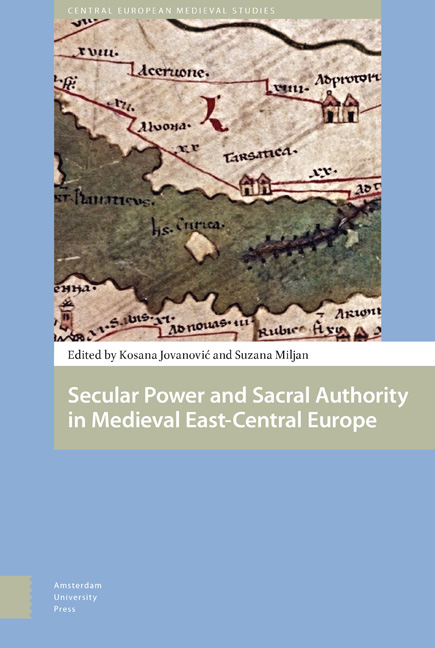Book contents
- Frontmatter
- Contents
- List of Figures and Tables
- Acknowledgements
- Foreword
- Folklore of the Medieval Kings of Hungary: Preliminary Research Report
- Variations on Nobility in Central and South-Eastern Europe: An Introduction
- The Changes of Office of Ban of Slavonia after the Mongol Invasion in Hungary (1242-1267)
- The Reconstruction and Role of Roads in the Formation of a Medieval Cultural Landscape: The Example of Episcopal Estates of Dubrava, Ivanić and Čazma
- From Castle-Warrior to Nobleman: Case Study of a Family of Slavonian Lesser Nobility
- Late Medieval Village in Turopolje (Slavonia): The Example of Donja Lomnica
- Economic Development and Transformation of the Pauline Monasteries near Senj under the Frankapan Patronage
- The Society of the Noble Judges in Northeastern Hungary during the Reign of King Sigismund (1387-1437)
- Development of Ragusan Diplomatic Service in the First Half of the Fifteenth Century: Father and Son at the Court of Duke Sandalj Hranić
- Croatian Students at the University of Prague in the Fifteenth Century
- A Contribution to Medieval Croatian Diplomatics: Cyrillic Charters of Croatian Nobility from the Franciscan Monastery on Trsat in Rijeka
- Peter of Crkvica, a Man Who Could Be Trusted: The Career of a Middle-Ranking Cleric and Diplomat in the Kingdom of Hungary in Mid-Fifteenth Century
- The Nobility of the Despotate of Serbia between Ottoman Empire and Hungary (1457-1459)
- List of Contributors
- Index
Folklore of the Medieval Kings of Hungary: Preliminary Research Report
Published online by Cambridge University Press: 12 December 2020
- Frontmatter
- Contents
- List of Figures and Tables
- Acknowledgements
- Foreword
- Folklore of the Medieval Kings of Hungary: Preliminary Research Report
- Variations on Nobility in Central and South-Eastern Europe: An Introduction
- The Changes of Office of Ban of Slavonia after the Mongol Invasion in Hungary (1242-1267)
- The Reconstruction and Role of Roads in the Formation of a Medieval Cultural Landscape: The Example of Episcopal Estates of Dubrava, Ivanić and Čazma
- From Castle-Warrior to Nobleman: Case Study of a Family of Slavonian Lesser Nobility
- Late Medieval Village in Turopolje (Slavonia): The Example of Donja Lomnica
- Economic Development and Transformation of the Pauline Monasteries near Senj under the Frankapan Patronage
- The Society of the Noble Judges in Northeastern Hungary during the Reign of King Sigismund (1387-1437)
- Development of Ragusan Diplomatic Service in the First Half of the Fifteenth Century: Father and Son at the Court of Duke Sandalj Hranić
- Croatian Students at the University of Prague in the Fifteenth Century
- A Contribution to Medieval Croatian Diplomatics: Cyrillic Charters of Croatian Nobility from the Franciscan Monastery on Trsat in Rijeka
- Peter of Crkvica, a Man Who Could Be Trusted: The Career of a Middle-Ranking Cleric and Diplomat in the Kingdom of Hungary in Mid-Fifteenth Century
- The Nobility of the Despotate of Serbia between Ottoman Empire and Hungary (1457-1459)
- List of Contributors
- Index
Summary
Having studied royal inauguration rites and related subjects, I often asked myself how much of all that display reached the subjects. If these symbolic signs and actions were to serve the legitimization of rule, then it was important that those who were ruled take cognizance of them and in some way or another ‘hear’ (and decode!) the message. Few students of these subjects raised this question – and even fewer found answers to it. A major exception was Marc Bloch, who had the good luck of finding records about the number of people who came to Reims to be healed by the king's touch: here we have an indication of how many Frenchmen ‘knew about’ the king’s divinely granted healing power. There are similar records for England as well. Perhaps the popularity of ‘pilgrimages’ to Nürnberg at the occasions of the showing of the imperial insignia as relics (Heiltumsweisungen) – of which the Holy Lance contained one, indeed – in the later Middle Ages could be counted as another proof of the widespread perception of the holiness of rulership and the importance of its signs and symbols. But, alas, no such obvious evidence seems to exist from other parts of Europe. Thus, we know very little about the ‘mute majority’s’ knowledge and understanding of all this, although that was the main purpose of the exercise.
As a kind of replacement, I intend to study the memoria of rulers in what may be termed folklore. As a first round in exploring possible sources for the folkloric ‘reception’ of royal status and character, I started looking at the veneration of kings of Hungary: the legends around a holy ruler, the tales and anecdotes about one late medieval king and a little jingle referring to another. All, or at least most, of the elements of these ‘memories’ are wellknown from folk tales and similar matters (songs, images) from several other cultures; the question, therefore, is, how and why these topics were attached to the three kings for which I found evidence: King St. Ladislas from the eleventh century, a little bit about Wladislas I from the mid-fifteenth, and quite a lot on Matthias I ‘Corvinus’ from the late fifteenth century.
- Type
- Chapter
- Information
- Publisher: Amsterdam University PressPrint publication year: 2018

